In their wonderfully tangible way mountains introduce, stymie and beckon. Heading northwest from Gyalthang (Zhongdian) through rows of brown folds Michael and I drop in altitude into the ‘rongba’ (valley towns) of hot valley floors only to ascend again into wider site lines and snow tainted wafts.
Travel through these shimmering valleys, snow passes and taupe colored ridge-lines has never been something one could take for granted. Pilgrims, traders and wanderers alike have vanished, reappeared or simply followed the paths provided by time and feet before.
We depart for Kawa Karpo/Kawa Gebo/Khawa Karpo Mountain (White Snow Pillar), one of eight major Tibetan mountain pilgrimage destinations, which sits on the eastern edge of the Tibetan Plateau. Sacred mountain sites (‘gnas ri‘ in Tibetan) are in many cases remnants and icons of the pre-Buddhist ‘Bon’ religion which took its influences from the natural world…and which hold on still. Kawa Karpo sits in cold clear light as we pass through – a glorious bulk that inspired cults in the ancient world that worshipped specific gods of mountains, lakes and trees. Seeing it again I wonder not at why it was (and is still) revered.
Almost eight hours of travel take us into the realm of sky and winds and then for a final descent south into the Mekong valley to a spec of houses near Ja Be. Old friend, trek mate and irrepressible energy force Kandro awaits.
Trekking mountains is one thing – a choice to be amid forces and set structures that diminish the body but enhance the senses. Michael and I have come to pay our own kind of physical homage not only to a mountain but to a ritual pilgrimage that circumambulates the mountain range – a total distance of more than 300 kilometers – that climbs and drops in increments of up to 2000 metres in a single day. For the Tibetans a pilgrimage and kora around Kawa Karpo is a once in a lifetime journey that promises a ‘better’ next life and a purification of the spirit itself. For Michael and I it represents a journey to trace ancient rite of passage that is set in tradition and animistic origins…
Kandro awaits in the darkness, his features and physicality unchanged in the years I have known him. His zeal for life hasn’t troubled his constitution in the least. He is smiling, filled with drink and gleaming with sweat…he is and always has been part mountain machine and part prankster. We meet along the Mekong’s dark gushing sounds and walk through dust and heat for an hour to get to his home.
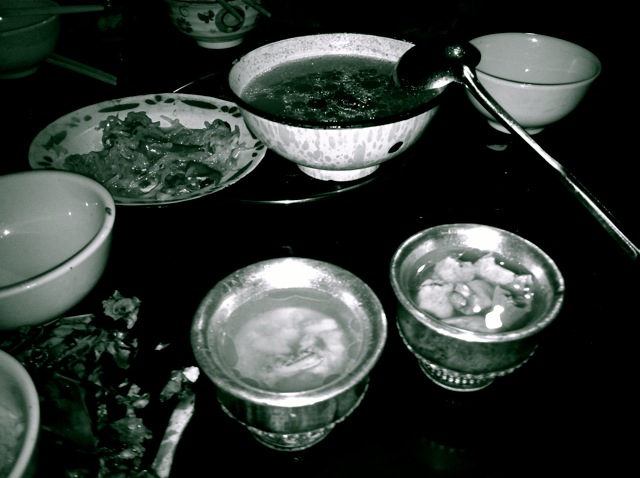
The potent welcome offering of Sha'ra - chicken that has been boiled for hours in local barley whisky
Next day our preparations, supplies and senses are prepped. Kandro’s equally indestructible wife will join us for our sojourn acting as a foil to Kandro’s energy, as well as that divine entity in any expedition, the cook – the one who, at the beginning and end of every day, sates, quenches and pleases the soul. Two other locals will aid in carrying our supplies. Mules at this time of year cannot be risked as already the early snows and winds have obscured the passes. My old friend, the distant but potent Shola Pass (which nearly took a friend’s life in a 2006 expedition along the Tea Horse Road) is apparently under snow already.

Our morning of departure needs the formidable assistance of mouthfuls of butter tea to kick start all of the organs
Autonomy is a key for us. We want all we need upon our backs within easy reach – it makes ‘journeying’ that much more tangible and selfish and experience.
Morning departure brings the welcome rush of leaving all things technical and cyber oriented. Our team, besides Kandro and his wife includes Reke, a quiet man of soft smiles and massive forearms and a soft faced giant, Tseba, whose shoulders seem built to haul the mountains themselves.
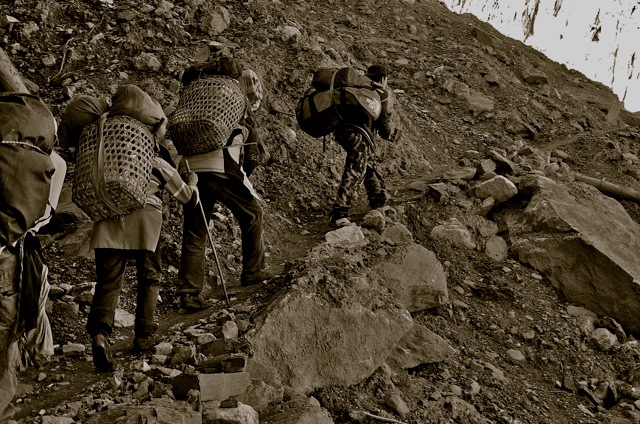
Our group of six make out along a ledge of stone. Horses and mules will not be risked in the snow passes that will surely come
Southeast of the greater range we head directly west through damp forests. Bolts of sunlight beam down in bright pockets…the weight of the packs, the clean air and sounds of gurgling streams send the mind into a free-fall of joy.
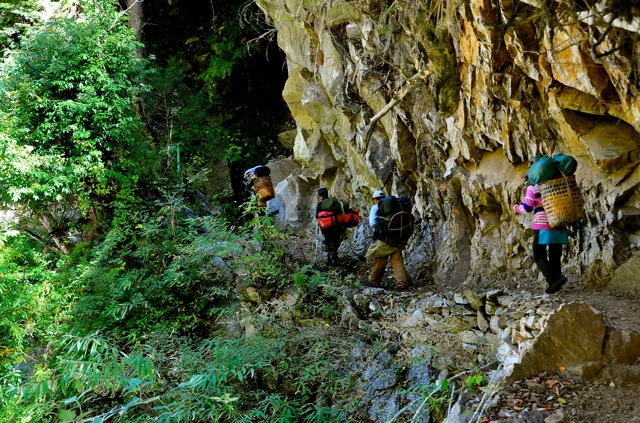
Ancient pathways lead further still into the mountain range. There are numerous kora routes...we stick with that which is said to be the most ancient pilgrimage path
Within two hours we are upon a path which neatly encompasses another path…and upon that path we are joined in our steps by nomads from far distant Chamdo in eastern Tibet. Worn faces, beaded hair and the dull wool chupas (woolen, ankle length robes) move forward in rough phalanxes bent under their supply packs. Everything they need for the coming two weeks or more is upon their backs…and in their hearts. Instantly their journey’s efforts and their motives are evident. Cheap running shoes, bamboo walking sticks and the eyes of the devoted drive them forward.

Women from near Chamdo in eastern Tibet move along the rugged pathways. We see no doubt in their eyes that they will complete the kora...a once in a lifetime experience for most
Michael mentions how our own journey seems somehow feeble compared to their own.
It is but the first day and there are many more steps to take, but we are here and we are already encased in the spirit of the place along with the smells of stale pungent butter and smoke which coat the pathways.



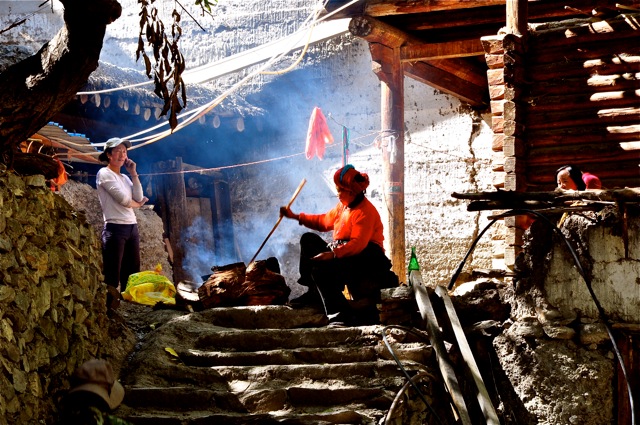

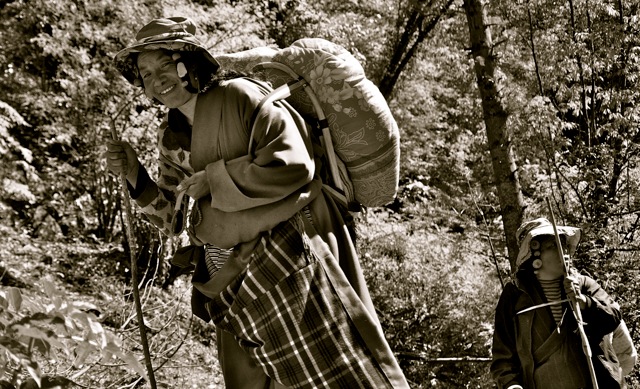
Great start to your posts about the kora, Jeff! I look forward to further episodes.
Best wishes,
Peter